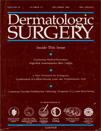Successful Removal of Traumatic Tattoos in Asian Skin with a Q-switched Alexandrite Laser
Abstract
background
Traumatic tattoos result from mechanical penetration of the skin by foreign-body particles associated with puncture, abrasive, or explosive trauma. Until the recent development of the Q-switched lasers, it was not possible to remove tattoo pigments without scar and pigmentary changes.
objective
The objective of this study was to determine the effectiveness of the Q-switched alexandrite laser (wavelength, 755 nm; pulsewidth, 100 ns), in treating the 27 cases of Asian skin with 36 traumatic tattoos and to observe any side effects such as scarring or pigmentary change.
methods
The results of treatments on 16 patients with 19 penetrant tattoos, 10 patients with 16 abrasive tattoos and 1 patient with bomb explosion were clinically analyzed.
results
Greater than 76% removal of tattooed pigments required an average of 1.7 treatment sessions in penetrant tattoos in contrast with 2.4 sessions in abrasive tattoos. The excellent removal of traumatic tattoos required 7.5 J/cm2 except the scarred region of one explosive tattoo and one abrasive tattoo on soil. There were no permanent side effects such as scar or permanent pigmentary changes.
conclusion
In conclusion, the Q-switched alexandrite laser is a safe and highly effective modality for removal of various traumatic tattoos without scar or permanent pigmentary change in Asian skin.




